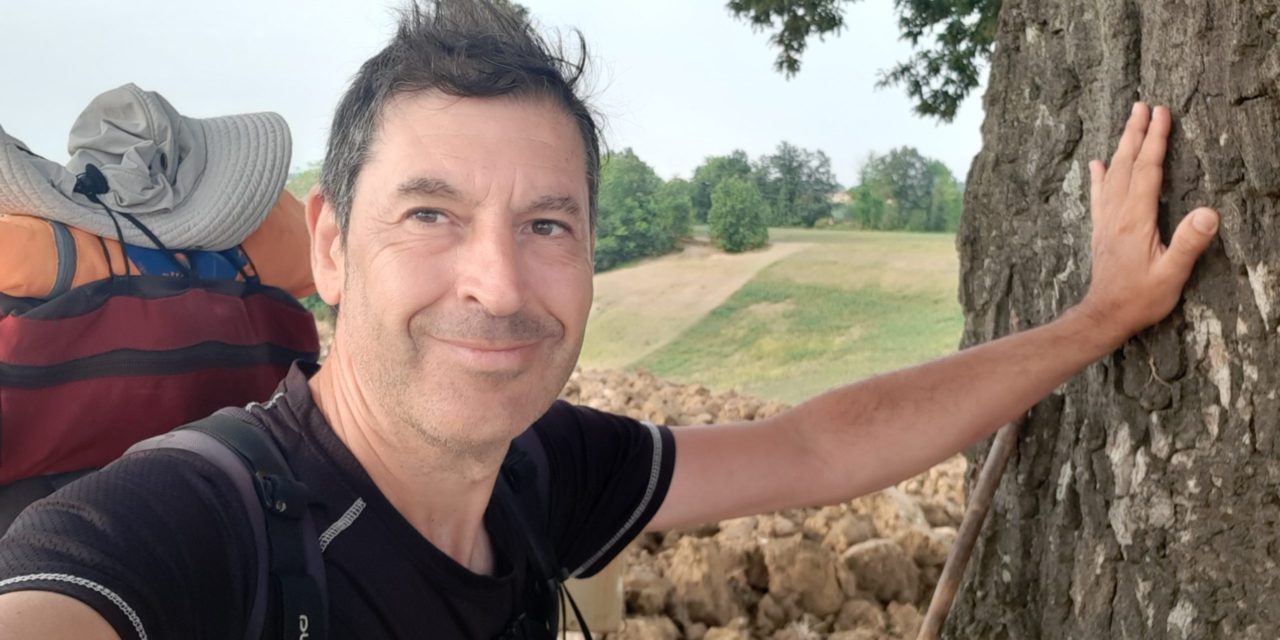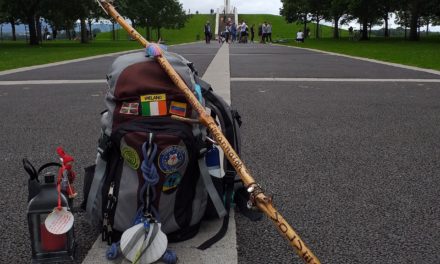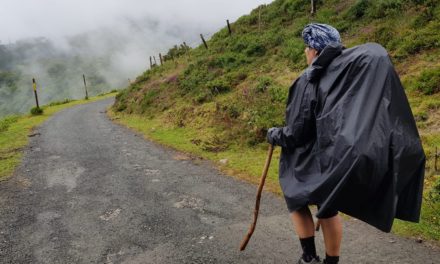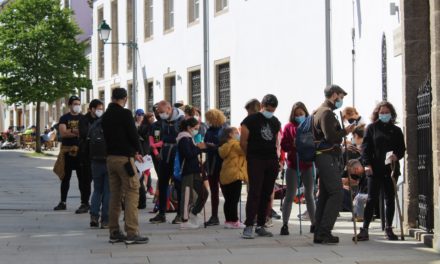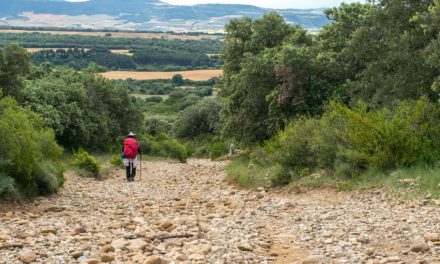Antón Pombo is an experienced pilgrim, a leading figure in Jacobean associations and a specialist on the Camino de Santiago. As a historian, researcher and writer, he has been publishing books, articles and guides for the different itineraries of the Camino de Santiago for decades, his publications in Anaya and Gronze being well known today. Precisely Gronze is behind his new project: a guide to the Via Francigena, the most famous of the Italian itineraries. We chatted with him about the pilgrimage itinerary to Rome, and its differences from and similarities to the Camino de Santiago.
-You are working on a guide on the Via Francigena that will appear soon in Gronze. Could you talk to us a bit about that project? On the one hand, we are interested in knowing how it was conceived, what was the aim behind it, but also more practical aspects: what field work did you do and what route of the Francigena did you choose…
It was my proposal to the publisher. It’s almost always the other way around, they offer me projects, but this time I proposed it because I wanted to do the Francigena, I really wanted to. They told me yes right away, because they wanted to have all the pilgrimage routes, something that gives prestige to a publisher. In addition, I am trying to open up to other ways. In general, my interest is in the pilgrimage routes that can be travelled on foot and are long, not only the Camino de Santiago but also other itineraries that meet with these criteria.
Regarding the chosen route, it was not feasible to cover the entire route, since the Camino historically begins in Canterbury, which makes it more than 2,000 kilometers long ! It was not feasible either for me or for them. In the end we chose to start in Lausanne, in Switzerland. This has been my longest pilgrimage so far, because it is a total of about 1,160 km which, counting some stops to collect information and my stay in Rome, meant 55 days of pilgrimage. I hiked from late August to October 13th.
-From your two points of view, as a pilgrim and as a specialist of the pilgrimage routes, what important aspects would you highlight of the Via Francigena?
There are many very interesting things on the Via Francigena. In the first place, I would highlight the long journey, the possibility it offers of getting to know several countries, from England through France and, in the section that I have chosen, the possibility of travelling through Switzerland and Italy from north to south.
On the other hand, it offers the experience of crossing the Alps, which is something mythical. I personally had a fantastic experience, also in the Apennines… Let’s say that from the point of view of the landscape it is a very rich and varied route. In that sense, it reminded me a lot of the Camino de Santiago, because it also has a great plateau-like plain, in the Padania (the Po Valley), and then with a very rich natural diversity: vineyards, olive trees, forests, etc. .
And from the point of view of heritage, it is a very rich itinerary, equal to or superior to the Camino de Santiago, I think that only the Camino Frances can compete in this. You find medieval walled cities, fabulous towns and villages, all well preserved and cared for… And it also ends in Rome, a place where you could stay for a long time.
Another attraction of this route would be the spiritual and religious dimension. In the case of the Francigena, I find this spiritual dimension in two aspects: the first is the welcome, because the welcome takes place largely in convents and parish churches, that is, traditional hospitality predominates; on the other hand, the arrival in Rome, to the tomb of Saint Peter, the basilicas, which constitutes an obvious attraction.
Another attraction for me is that there are few people. This aspect can be exaggerated. But I have spent days alone, without being able to talk to anyone in hostels or on the Camino. Or else you find people who use the infrastructure, but not for pilgrimage, they go hiking. But in Tuscany and Lazio there are people, in that area it is similar to the Camino. By the way, the theme of the credential is also the same as the Camino and they have the Testimonium, the name of their Compostela.
It also occurs to me to mention the airports as something positive about the Francigena, the presence of airports that facilitate rapid access and have low-cost airlines; also the fact that it preserves a certain point of adventure and that, being just the beginning, the pilgrim has a fine stretch at the outset, which is not the case here in Galicia.
-In line with the previous question, I would also like to know what weak points you have found on the Italian way…
There is a fundamental weak point: they have built the house from the roof down. In Santiago they began with the base, the pilgrims, the associations… There they already started with a great association with European funds and institutions, but they had to resort to the church for the accommodation issue that they had neglected to deal with. The church lent a hand and it was only thanks to them that the thing worked. But they all started from the institutions, that is why there is no “popular” feeling of appreciation for the Via Francigena as there is here for the Camino de Santiago.
Regarding the numbers, it is complicated, they account for everyone, they include hikers… But if you limit yourself to the number of Testimonium, the figures are low: the Via Francigena Association points out that in 2019 there were 50,000 users who stayed for at least one week, but in Rome the figure of 10,000 was calculated last year, and in 2019 the number of those who arrived was estimated to be about 15,000.
There are problems that have been overcome on the Camino that are still present there: signalling problems, poorly marked stages. In addition, the itinerary is not one hundred percent fixed- it changes, local interests are thought to be at stake … It is a bit immature, really. Another problem has to do with accommodation, because the church cannot be everywhere nor does it not have enough space, lodgings are in short supply, hostels are too small…On the busiest days and on the most crowded sections accommodation has to be booked, even two or three days in advance, because a small group can completely fill up a local shelter.
Another negative aspect is that the Francigena is still considered a second option. For example, most of its pilgrims have already done the Camino de Santiago. Most are Italian, then German, French, Swiss and North Americans. And, in addition, the fact of being such a long route has positive aspects, but it also makes it difficult to establish a starting point. Most of the pilgrims start in Tuscany, in Lucca… but this way you miss the Alps!
-And so we come to the comparisons: What do you think a pilgrim accustomed to the Camino de Santiago is going to discover in the Francigena? And what is he going to miss?
He will discover that they are trying by every means to make the Francigena the Camino de Santiago 2, but without success. It is true that the Confraternita de Perugia, the HOSVOL… are creating shelters, but it is not the most visible. They will also discover something resembling the Camino de Santiago in the 90s, with everything starting up, people trying to please, treating you well, making special offers for pilgrims… But it is more expensive to do the Francigena than the Camino de Santiago!
They are going to miss a lot of things: organisation, signposting, an infrastructure, people from many countries… And I think they will also miss the spirit of the camino, because although there are people, many are hikers who spend a week in Tuscany without considering reaching Rome, they have very different visions.
The presence of people from other countries, the international presence, is very restricted. A few from the Anglo-Saxon world, but hardly anyone from South America (except Brazil or Argentina), Asia (some from China, South Korea, Japan), very few from Eastern Europe, etc. And many people, despite being willing to, do not give you the information that you get here, information is lacking. Of course, the church is more present there than here, with blessings, masses, accommodation, etc.
-Looking to the future: Do you see a possible development in the Francigena similar to that of the Camino de Santiago? How could the two pilgrimages collaborate and feed each other…should more weight should be given to the union of both pilgrimage destinations: Rome and Santiago?
I am convinced that it will be successful in the medium term, because the itinerary is so beautiful! But they have to change the promotion and communication strategy. The message they communicate is the wrong one. They are more successful on the Camino de San Francesco because there is more spirituality and more of a pilgrim spirit, that’s why it works. For hiking, any place is worth it, that’s why when they focus on a tourist strategy they fail; because they compete with all tourism, without the specific quality of pilgrimage, of the personal value of that experience…
Regarding the Rome-Santiago route, the Camino is signposted in both directions, but 95% of the pilgrims who travel the Francigena limit themselves to the section from north to south in Italy or, at most, from Switzerland. I think that both paths are inevitably going to compete with each other, they will compete to attract pilgrims. In fact, there they told me: you have to tell everyone to come because there are still few people here! And that is legitimate.
Rome-Santiago / Santiago-Rome is a manageable route divided into several years, it is true that there might be a possibility of a collaboration, but it is not easy. In the end, the Francigena is a north-south axis… And, in any case, it is necessary to manage the entire route, with France in the middle as a necessary collaborator… I would like there to be two-way paths, one for travelling north, and one for those heading south, perhaps for the Spanish to make a pilgrimage to Rome… But both things seem difficult.
-As a collaborator of the Foundation you know that we are interested in the subjective experience of the pilgrims… Could you tell us something about your experience as a pilgrim in the Francigena?
It has been such a long experience! I admit that I felt very alone in Padania, Val d’Aosta… but in the end that strengthens you and makes you more resilient, it teaches you to fend for yourself. Yes, I’ve been alone for days, without seeing anyone, walking around eating dinner and sleeping alone. In Switzerland I was alarmed by the prices, hostels that charged 50 euros for bed and breakfast…
But I have also had the experience of crossing the Alps on foot, a fantastic experience: arriving at the Gran San Bernando, attending mass and the blessing. On the other hand, the Italians are very hospitable, they treat you wonderfully, and the last two weeks I had a great time, with Italian pilgrims who helped you with everything, cooked, made reservations… And there I also met pilgrims from other countries. And also the ending was fantastic: I arrived on a Sunday and managed to see the Pope. I entered Saint Mark’s square just when the Pope was there. That end of the Camino in Rome was something very warm and special, similar to the arrival in the Middle Ages. And especially pleasant the experience of staying in hospital hostels: Vercelli, Pietrasanta, San Gimignano, etc.
-I cannot avoid asking you about the Camino de Santiago, how do you see the Holy Year that is beginning?
I think there is going to be an avalanche, which is what many of those who are in charge of the Camino want. In that sense, it will be a success, but I believe that we have not taken advantage of the experience of the pandemic to redefine the Path and that from the success in pure numbers we will reach a great crisis. I hope that some routes such as the French Way are being ‘cleaned up’, in fact, the competition from other itineraries is good, it improves the profile of long-distance pilgrims on the French Way.
-To finish, I would like to ask you if you already have any other project in mind…
Yes! Walk the Camino de San Francisco and perhaps a book on the Camino de Arles.

